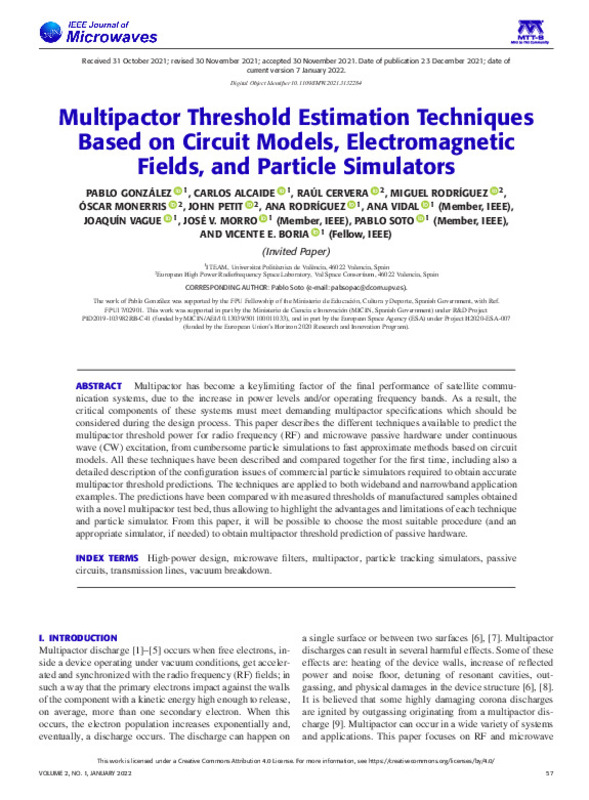González-Santatecla, P.; Alcaide, C.; Cervera, R.; Rodríguez, M.; Monerris, Ó.; Petit, J.; Rodríguez Pérez, AM.... (2022). Multipactor Threshold Estimation Techniques Based on Circuit Models, Electromagnetic Fields and Particle Simulators. IEEE Journal of Microwaves. 2(1):57-77. https://doi.org/10.1109/JMW.2021.3132284
Por favor, use este identificador para citar o enlazar este ítem: http://hdl.handle.net/10251/187283
|
Título:
|
Multipactor Threshold Estimation Techniques Based on Circuit Models, Electromagnetic Fields and Particle Simulators
|
|
Autor:
|

 González-Santatecla, Pablo
González-Santatecla, Pablo

 Alcaide, Carlos
Cervera, Raúl
Rodríguez, Miguel
Monerris, Óscar
Petit, John
Alcaide, Carlos
Cervera, Raúl
Rodríguez, Miguel
Monerris, Óscar
Petit, John
 Rodríguez Pérez, Ana María
Rodríguez Pérez, Ana María

 Vidal Pantaleoni, Ana
Vidal Pantaleoni, Ana

 Vague, Joaquín
Vague, Joaquín

 Morro, J. V.
Morro, J. V.

 Soto Pacheco, Pablo
Soto Pacheco, Pablo

 Boria Esbert, Vicente Enrique
Boria Esbert, Vicente Enrique
|
|
Entidad UPV:
|
Universitat Politècnica de València. Instituto Universitario de Telecomunicación y Aplicaciones Multimedia - Institut Universitari de Telecomunicacions i Aplicacions Multimèdia
Universitat Politècnica de València. Departamento de Comunicaciones - Departament de Comunicacions
|
|
Fecha difusión:
|
|
|
Resumen:
|
[EN] Multipactor has become a keylimiting factor of the final performance of satellite communication systems, due to the increase in power levels and/or operating frequency bands. As a result, the critical components of ...[+]
[EN] Multipactor has become a keylimiting factor of the final performance of satellite communication systems, due to the increase in power levels and/or operating frequency bands. As a result, the critical components of these systems must meet demanding multipactor specifications which should be considered during the design process. This paper describes the different techniques available to predict the multipactor threshold power for radio frequency (RF) and microwave passive hardware under continuous wave (CW) excitation, from cumbersome particle simulations to fast approximate methods based on circuit models. All these techniques have been described and compared together for the first time, including also a detailed description of the configuration issues of commercial particle simulators required to obtain accurate multipactor threshold predictions. The techniques are applied to both wideband and narrowband application examples. The predictions have been compared with measured thresholds of manufactured samples obtained with a novel multipactor test bed, thus allowing to highlight the advantages and limitations of each technique and particle simulator. From this paper, it will be possible to choose the most suitable procedure (and an appropriate simulator, if needed) to obtain multipactor threshold prediction of passive hardware.
[-]
|
|
Palabras clave:
|
High-power design
,
Microwave filters
,
Multipactor
,
Particle tracking simulators
,
Passive
circuits
,
Transmission lines
,
Vacuum breakdown
|
|
Derechos de uso:
|
Reconocimiento (by)
|
|
Fuente:
|
IEEE Journal of Microwaves. (eissn:
2692-8388
)
|
|
DOI:
|
10.1109/JMW.2021.3132284
|
|
Editorial:
|
Institute of Electrical and Electronics Engineers Inc.
|
|
Versión del editor:
|
https://doi.org/10.1109/JMW.2021.3132284
|
|
Coste APC:
|
1880 €
|
|
Código del Proyecto:
|
info:eu-repo/grantAgreement/AEI/Plan Estatal de Investigación Científica y Técnica y de Innovación 2017-2020/PID2019-103982RB-C41/ES/DISEÑO AVANZADO DE NUEVOS COMPONENTES DE ALTA FRECUENCIA EN TECNOLOGIAS GUIADAS COMPACTAS PARA FUTUROS SATELITES DE TELECOMUNICACION/
info:eu-repo/grantAgreement/ESA//H2020-ESA-007/
info:eu-repo/grantAgreement/ //FPU17%2F02901//AYUDA CONTRATO PREDOCTORAL FPU-GONZALEZ SANTATECLA. PROYECTO: OPTOMECANICA DE CAVIDADES: DIELECTRICOS A METALES/
|
|
Agradecimientos:
|
The work of Pablo González was supported by the FPU Fellowship of the Ministerio de Educación, Cultura y Deporte, Spanish Government, with Ref.
FPU17/02901. This work was supported in part by the Ministerio de Ciencia e ...[+]
The work of Pablo González was supported by the FPU Fellowship of the Ministerio de Educación, Cultura y Deporte, Spanish Government, with Ref.
FPU17/02901. This work was supported in part by the Ministerio de Ciencia e Innovación (MICIN, Spanish Government) under R&D Project
PID2019-103982RB-C41 (funded by MICIN/AEI/10.13039/501100011033), and in part by the European Space Agency (ESA) under Project H2020-ESA-007
(funded by the European Union's Horizon 2020 Research and Innovation Program).
[-]
|
|
Tipo:
|
Artículo
|









